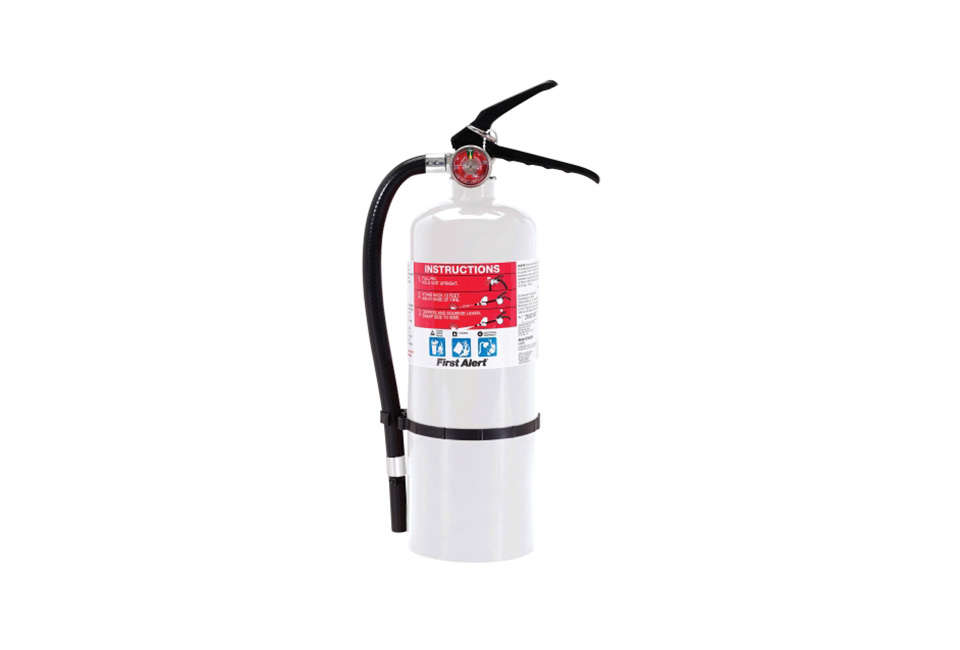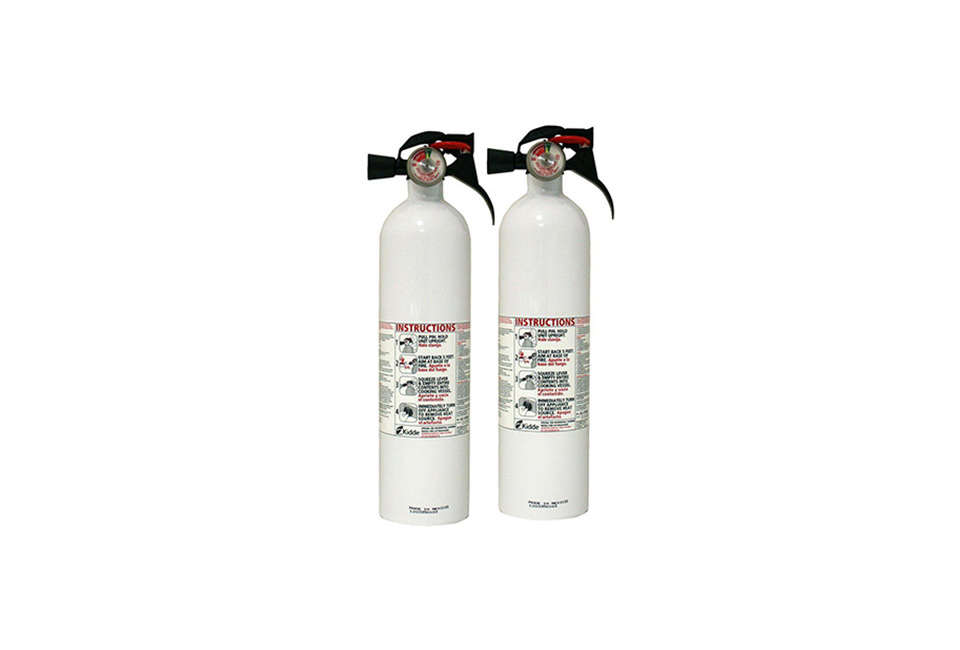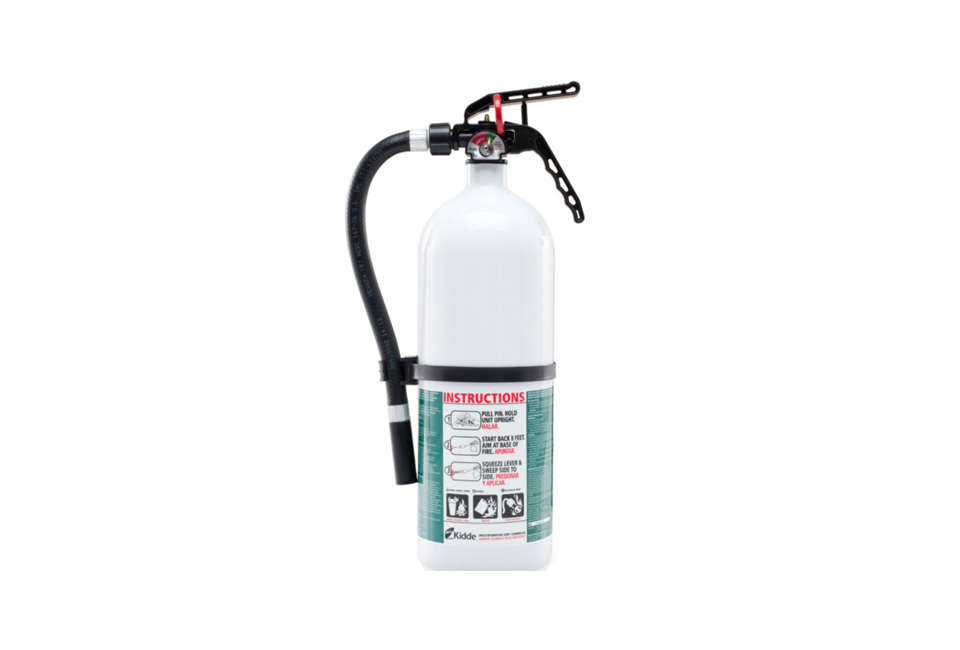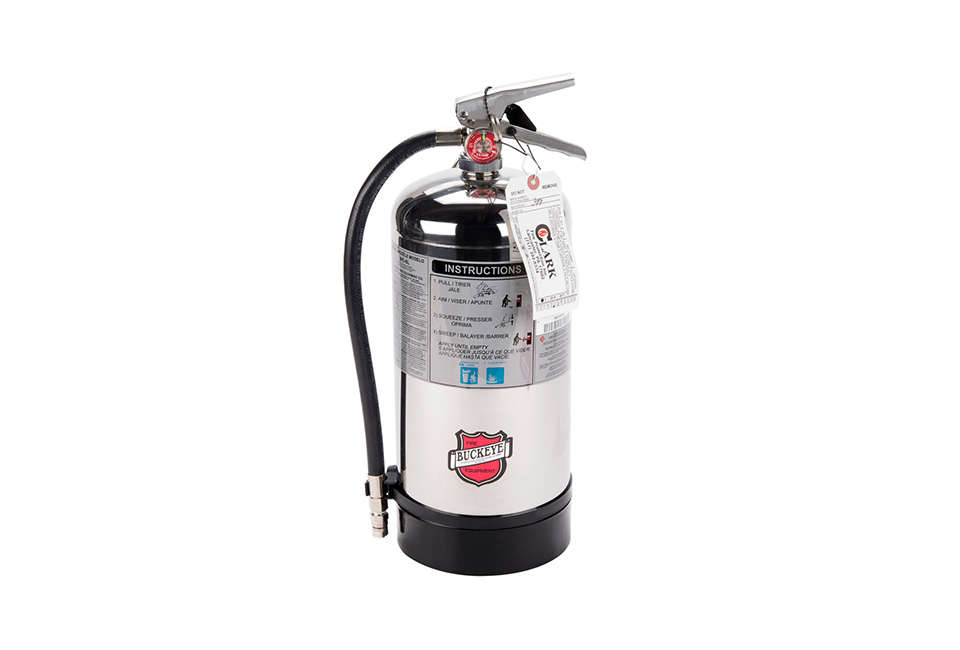
Every home needs at least one fire extinguisher that’s kept readily at hand. And yet many homeowners either (A.) know they don’t have a fire extinguisher and don’t think it’s a problem (I’m embarrassed to admit I was in this category until I started researching this post), or (B.) own a fire extinguisher (or several) but have no idea how to operate it or even if it would still work in case of a fire. Here’s what you should know about fire extinguishers to help keep your home and family safe.
Above: Spotted at the La Garçonne boutique in New York City: a sleek silver fire extinguisher. Photograph by Michael A. Muller for Remodelista.
1. Do I really need a fire extinguisher in my home?
You do; every home should have at least one portable fire extinguisher installed in an easily accessible spot. The National Fire Protection Association (NFPA) has determined that almost half the fires in the home occur in the kitchen, so that’s a good place to start.
Above: A tried a true option: The Kidde Fire Extinguisher Pro 210 weighs 7.5 pounds and is suitable for classes A, B, and C; $49.99 via Kidde.
2. How many fire extinguishers should I have, and where?
According to the NFPA, you need a fire extinguisher on each floor of your home, including the basement. One in the garage is also recommended. They should be installed in spots that are easy to reach—and close to an exit so you don’t have to run past the flames to leave the area if the fire cannot be controlled.
Above: The First Alert 2-A:10-B:C Heavy Duty Rechargeable Fire Extinguisher is currently on sale for $53.99.
3. How do I choose a fire extinguisher?
The label on the device will show a rating that includes some or all of the letters A, B, and C. These indicate the different types of fire that a particular device can handle: A is for ordinary combustibles like trash, wood, paper, and cloth. B is for flammable liquids, such as cooking oil, gasoline and paint thinner. C is for live electricity—electrical appliances or machinery, wiring, fuse boxes. (K is sometimes used to designate kitchen-specific extinguishers that fight cooking oil and grease fires.)
The number before the A or B indicates the device’s relative effectiveness against that type of fire. (The C designation never has a number.) The NFPA recommends at least 2-A and 10-B. Luckily, there are multipurpose ABC fire extinguishers, so you don’t need to stop to consider what type of fire you’re fighting.
However, the flame-retardant chemical in an ABC extinguisher can damage the surface of your oven. For that reason, some homeowners opt for a BC extinguisher in their kitchen, since a fire there will most likely be caused by cooking oil.
Look for a fire extinguisher that’s not too heavy for you and your family members to handle, has clear and easy-to-read instructions on the label and pressure gauge, and has a rating certified by Underwriters Laboratories. Amerex, Kidde, and First Alert are among the reputable brands.
Above: The Kidde Kitchen Fire Extinguisher is lightweight, disposable, and suitable for B and C fire types. A set of two is $39.94 via the Home Depot.
4. Is there more than one type of fire extinguisher?
Basically, these devices are either reusable (those with metal valves) or meant for one-time use only (those with plastic valves). Once you’ve used a rechargeable model, you’ll need to contact a fire extinguisher company to have it refilled (if necessary, ask your local fire department for advice). If you use a disposable unit, you’ll have to buy a new one, which will probably cost you more than refilling a rechargeable device.
While smaller fire extinguishers just have nozzles on top, larger models come with hoses that make it easier to target the base of the flames. Aerosol cans are also available, but these are less effective and in some cases can actually spread the flames.
Above: We like the turquoise band around the Kidde Living Area Fire Extinguisher; it’s $49.99 and comes with a wall hanger.
5. Does a fire extinguisher last forever?
The standard fire extinguisher is a steel cylinder containing a dry chemical held under pressure so you can shoot it out through the nozzle or hose without getting too close to the flames. The cylinder loses pressure over time, so you should check your devices regularly (once a month is recommended) to make sure they’ll function properly if needed. How do you check them? Easy! The gauge on the neck of the tank indicates the pressure level: If the needle is in the green zone; you’re good. Red means the charge is too low. And any fire extinguisher should be replaced if it’s more than 10 to 12 years old.
Above: The heavy-duty 6-Liter Wet Chemical Fire Extinguisher by North Carolina company Buckeye has a shiny chrome exterior and is intended for kitchen fires; $135.99 via Webstaurantstore.com.
6. Can anyone operate a fire extinguisher?
Here’s where size is important: You don’t want a fire extinguisher that’s too heavy for someone in your family to lift. A 10-pound model may pack a lot of power, but it could be hard for a smaller person to handle. (Note that the weight listed generally refers to the amount of chemical inside; add on the weight of the cylinder.) A smaller unit closer to five pounds is a good general size.
While a fire extinguisher is easy to operate, everyone in your home should familiarize themselves with the device by reading the instructions and looking over the parts. As for using it, the NFPA has a mnemonic device: Think PASS.
- P stands for “pull the pin” to release the lock on the nozzle. Obviously, you’d point the nozzle away from your body as you do this.
- A stands for “aim low.” That means directing the stream at the source of the fire, not at the leaping flames.
- The first S is a reminder to “squeeze” the lever slowly and evenly.
- The second S reminds you to “sweep” the nozzle from side to side as you release the flame retardant.
Fire safety rules stipulate that you should call 911 as soon as a fire is spotted and only tackle a fire yourself if it’s small and self-contained. It’s important to have your exit behind you when you use the fire extinguisher so you can make an easy escape if necessary. If the fire is spreading and the room is filling with smoke, evacuate the building immediately. Obviously, saving lives is more important than saving property.

Above: Spotted on Pinterest: this aspirational matte white fire extinguisher, designed by Stockholm shop Asplund in collaboration with Swedish fire safety company Brandsläckaren.se. We’re hoping a similar option becomes available in the U.S. soon.
Unfortunately, it’s not possible to do a test run with your fire extinguisher, unless you’re willing to recharge (or replace) it afterwards. But fire departments often schedule training sessions to let homeowners give it a try. Meanwhile, act now to equip your home with at least one of these necessary devices.
For more on fire safety, see our posts:












Have a Question or Comment About This Post?